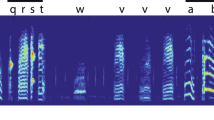Abstract.
Many songbirds develop remarkably large vocal repertoires, and this has prompted questions about how birds are able to successfully learn and use the often enormous amounts of information encoded in their various signal patterns. We have studied these questions in nightingales (Luscinia megarhynchos), a species that performs more than 200 different types of songs (strophen), or more than 1000 phonetically different elements composing the songs. In particular, we investigated whether and how both song repertoires and song performance rules of nightingales were coded by auditory stimuli presented in serial learning experiments. Evaluation of singing episodes produced by our trained birds revealed that nightingales cope well with an exposure to even long strings of master song-types. They can readily acquire information encoded within and between the different master songs, and they memorize, for example, which master song-types they have experienced in the same learning context. Imitations of such song-types form distinct sequential associations that are termed “context groups”. Additionally, nightingales develop other song-type associations that are smaller in size and termed “package groups”. Package formation results from constraints of the acquisition mechanisms which obviously lead to a segmentation of auditorily perceived master song sequences. Further experimentation validated that the song memory of nightingales is organized in a hierarchical manner and holding information about “context groups” composed of packages, “package groups” composed of songs, and songs composed of song elements. The evidence suggests that implementation of such a hierarchical organization facilitates a quick retrieval of particular songs, and thereby provides an essential prerequisite for a functionally appropriate use of large vocal repertoire is in songbirds.
Similar content being viewed by others
Author information
Authors and Affiliations
Additional information
Received: 4 October 1997 / Accepted in revised form: 26 August 1998
Rights and permissions
About this article
Cite this article
Todt, D., Hultsch, H. How songbirds deal with large amounts of serial information: retrieval rules suggest a hierarchical song memory. Biol Cybern 79, 487–500 (1998). https://doi.org/10.1007/s004220050498
Issue Date:
DOI: https://doi.org/10.1007/s004220050498




